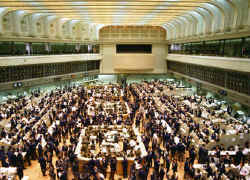Stock Market: Follow the Leader

To make money in the stock market, you have to understand risk. Physicists have been using statistical physics methods to analyze markets in order to better understand market risks, such as the probability that a large shift in market value will occur during a year-long interval. Real markets have a higher probability of experiencing large changes than conventional “pure chance” would predict, and econophysicists have suggested many schemes to explain this fact. The latest idea, reported in the 25 December PRL, points to the “herding behavior” for which traders are famous. The authors describe a simple computer model where information networks grow randomly until entire “clusters” of traders act on the news and then wait for the next “rumor mill” to grow. The model predicts price fluctuations similar to those of real markets.
The great advantage of studying markets, rather than other complex systems in society, is the huge amount of data stored on computers, which record every transaction worldwide, says H. Eugene Stanley of Boston University. Last year, in a mammoth study [1] of second-by-second stock prices, Stanley and his colleagues showed that great crashes and bubbles are not singular events which are totally unlike smaller market swings. Instead, there is a universal inverse fourth power relationship between the size of a price fluctuation and its frequency, no matter how large the change. This so-called power-law, or “fat tail” behavior–which has been suggested by many smaller studies–is not predicted by conventional random fluctuations and is not accounted for by the analysis schemes that financial managers use.
There are some complicated models of markets that can lead to fat tail behavior, but Víctor Eguíluz of the Niels Bohr Institute in Copenhagen and Martín Zimmermann of the University of Buenos Aires wanted a simpler approach. Their model–worked out at the Mediterranean Institute for Advanced Study (IMEDEA) in Palma de Mallorca, Spain–is a modification of one proposed earlier this year [2] where traders, or “agents,” are represented by vertices in a network of random connections. Linked agents represent groups of investors who share the same information, opinion, or analysis tools, and they make identical buy and sell decisions. That model led to power law distributions of market fluctuations, but only if the density of links was within a narrow range. And the model was static: The number of links was fixed in time.
In Eguíluz and Zimmermann’s new model, the links evolve in time. At the beginning of each time step, a random agent is chosen to be either active–by buying or selling–or to spread information, by creating a link with another random agent. If an agent is active, its entire cluster follows the agent’s lead. Following a buy or sell, the entire cluster’s network of connections disappears, representing the fact that the information has been used, or has “expired.”
When Eguíluz and Zimmermann set the likelihood of an agent to be active at a small value, then information spread quickly, and large clusters formed. The price fluctuation distributions were largely power laws, with only small exponential tails. With slower spreading of information, the distributions contained a smaller range of power law behavior. The results further strengthen the evidence that herding behavior may be largely responsible for fat tail distributions in market fluctuations.
Stanley says the herding behavior captures the essence of the fat tails. “With this concept and not much else, they can get in the right direction of explaining our findings.” Stanley believes that as the models improve they may eventually lead to improved risk assessment tools for money managers.
References
- V. Plerou et al., Phys. Rev. E 60, 6519 (1999)
- R. Cont and J. P. Bouchaud, Macroeconomic Dyn. 4, 170 (2000)


